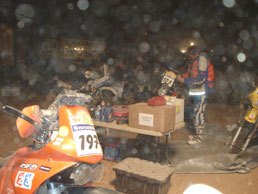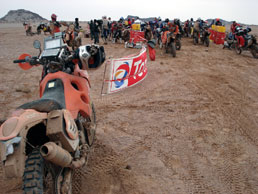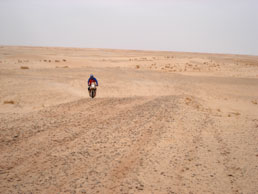 |          |  | ||
 | ||||
Dakar Diary (click images for full-size view)
| ||||
|
Dakar Diary-6
The sandstorm throughout the night made it nearly impossible to get any real rest. I liken the whole bivouac experience to trying to sleep while laying in the middle of a NASCAR pits. There are constantly generators running all night, motors running all night, cars, truck and bikes revving their motors to the rev-limiters, welders, grinders and all sorts of pit craziness. Today’s stage is the longest of the rally at 817km. 414 for the morning liaison, 394 for the Special and another 9 to get in to the evening bivouac. In order to get everyone out on time the first bike left at 4:30 in the morning. Steve and I weren’t far behind. With my requisite two hour coffee/prep that means I was up at 3. I don’t think I have been up that early since the military but believe it or not I was sort of getting used to it. By the time my watch would go off I was pretty much ready to get the day started. I don’t know what time Tim got in but he couldn’t have gotten more than a couple hours sleep. It isn’t any one thing that wears you down but the combination of long days in the saddle followed by a few bad nights of sleep and suddenly your body is running on fumes and making mistakes. The stress of the days ride only adds to the exhaustion and I think that is what happened to Tim. One moment’s lapse in concentration and pretty soon you are on the ground wondering what just happened. Steve and I left the bivouac around 5 in an absolutely horrible, sideways-blowing sandstorm. I am pretty sure I have never ridden in anything like this before including the famous Ruta 40 in Argentina. The visibility was reduced to something around 10 feet in front. We had to be so careful to keep an eye on the taillight in front and pray no one decides to stop in the middle of the road. You also had to keep an eye out for camels, goats and donkeys pulling rickshaws along the side of the highway. I couldn’t believe how crazy it was. I was in my helmet crouching down to get out of the wind and swearing aloud to the weather gods to give us little break. I had on every bit of clothing I owned and still the cold was biting through the layers like nothing else. This went on for probably 100 km or so but it took us a couple hours. Eventually my prayers were answered and the sideways sand subsided but not before the rainstorm hit. Rain! In Africa! You have got to be kidding me. If I was swearing to the weather gods before I was full on screaming at them now. Again, I couldn’t believe it. The rain soaked through all of our summer riding suits and the real cold set in. That was seriously one of the most uncomfortable rides I have ever had. Cold, wet, windy, dirty and dangerous. What else could there be? How about a little mud thrown in for good measure? How about 200km of the shit? After the first 200km of the liaison the road turned to dirt, er, mud. Not just mud but nasty, slick, gooey peanut-butter mud. It was everywhere. The tires would pack up with it and sling all over and into the bellypan, radiators and anywhere else I could find a home. There were guys crashing out all over the place and we hadn’t even reached the race course yet. With all the weight of full tanks the bikes were a real challenge in the slick stuff. There was no easy way to go but just keep moving forward.
Zouerat is our first stop in Mauritania and it is known for being something of an armpit. Most of the bivouacs are but this one is supposed to be particularly nasty so we had that going for us. I got to the point where me and the voices in my helmet would go on and on about the stage to pass the time. We would talk about the bike or the weather or the tracks, anything but how many kilometers were left before the day was over. I would try desperately to not look at my ODO for a certain distance but this only lasted a few miles. The only way to make it pass was to break it down into a bunch of tiny stages. First, there is the 50km milestone, then 100km, then 1/3 of the way milestone, then halfway and after that you are into the short rows. Me and the voices would calculate kph and try to determine at what time we’d finish up the day probably 7 or 8 times per day. Mostly I needed to figure out if we were going to see darkness on the stage so that would motivate me to keep moving forward. At times it was almost comical but for whatever reason the voices kept me entertained. I didn’t think I would ever have a problem with the solitude of the Dakar. I had heard from more than a few Dakar veterans that the solitude of days and days in the saddle starts to wear on a person and over time can drive you nuts. I know you are always within a few km of the other competitors but something about being alone in the desert compounds the feeling of isolation. I think motorcyclists by nature are probably pretty comfortable being alone otherwise they wouldn’t have chosen such a solo sport. There is something very peaceful about not talking for hours and hours in the saddle with the only noise to break the monotony is the hum of a perfectly tuned rally motor. I never understood those people that ride with intercom systems. I can’t imagine anything more disturbing than having to listen to a real voice in your head while trying to navigate the day on a bike. Music maybe but not a real voice. For a few days now I have been hearing what seemed to be an exhaust leak on my bike. Every stop I would inspect the entire system for something amiss but the mud made today’s inspection difficult. I figured if it got worse I would deal with it but until then I had plenty of other things to worry about. Well, it got worse. Suddenly in the middle of the track something gave and I had a massive leak. It was backfiring and spitting every time I would let off and I noticed a huge drop in power. There wasn’t a lot I could do in the middle of the desert so I talked with Steve about it and we decided to try to make it to the end of the stage and inspect it at the bivouac. An airleak is never good. In extreme cases it causes a lean condition and if not addressed will burn a hole in the piston and/or burn a valve. I couldn’t afford either so I took it easy. Pretty soon engine noise got to the point where it sounded like something really wrong was about to happen. The head must have heated up because the valves were clattering like crazy. As luck would have it we came up on a gas stop. The timing couldn’t have been better for a couple reasons. Steve and I reached the gas stop around the same time. Unlike most of the other stops we actually got our gas in less than 10 minutes. Most of the gas stop attendants are locals that the ASO has employed to fill everyone up in a timely and efficient manner. You would think that for the price of admission and gas they could also include a few good funnels for the guys but from day one they were forced to use cut-in-half water bottles as funnels. More than once this turned out to be very frustrating watching your bike repeatedly doused in fuel while they figure out the exact angle of the spout. One time in particular while Steve was refueling on the bike the spout backfired and hosed down pretty much all of his pants and as a result turned his nether regions into a veritable bonfire. He complained for days before the doc, Jonathan Edwards, could supply him with an ointment to relieve the “burning sensation”. I hated that for him. That’s the last thing you need is more discomfort on the trail. Anyway, so here we are at the gas stop enjoying our lunch of Clif bars and water when I noticed my entire rear subframe was in danger of falling off. It holds my rear fuel tank and toolbox as well as the seat, battery, airbox and all the electrics for the bike. “Holy cow! The whole thing is coming off”. Something was dramatically wrong. During the build process off the bike I Loctited EVERY SINGLE nut and bolt on the bike. This wouldn’t have helped. The 8mm bolts that were holding everything together had sheered off and started to round out the holes in the frame itself. So now I had the air leak to deal with and the frame to reattach. Any farther down the trail and the pounding and vibration could have made this a race-ending event but luckily we were able to sort it out over energy bars. For the leak I traced it down to a little aluminum plug that is usually used for emissions on the street version of my bike. The plug over the last 4000km had just vibrated loose and blown out. The chances of tracking down another one within a couple thousand miles was nil. The only option I had was to try out my MSR metal, a two-part epoxy I had thrown into my kit at the last minute. I almost always carry some sort of liquid metal but in all the years I have never needed to use it on the trail. If ever there was a time I needed it to work it was right now. Steve and I wondered aloud if it would work since he had never used it either. I had nothing to lose. By this time my hands had really started to become a challenge to work with. I could barely operate the zippers on my gear or use the tools in my kit. For some reason I had lost almost all the dexterity in both hands and the new challenge only added to the frustration. All I could do was ball up a couple Bubbalicious-sized wads and jam it in the hole and hope it held together. There was no way to clean out all the mud and crap that accumulated over the last 6 days so I just included it in my repair. I had my doubts about the metal though I had heard amazing stories of its success. Since it needed 15 minutes to set I thought it would give me enough time to repair the rear subframe. Luckily I had stashed some spare 8mm nuts and bolts in my kit for just such an emergency. I couldn’t believe my good luck. In the middle of this otherwise really crappy day I was potentially saved by something I had almost thoughtlessly done nearly two weeks earlier in Lisbon. Steve helped me lift up the tank and force the new hardware into place and 15 minutes later we were back on the trail. The extra maintenance put us a little behind but without it my day surely would have ended in the middle of the desert. I was lucky to have Steve close by. My hands made it nearly impossible to do anything with the tools by myself. We were back on course and moving along toward Zouerat in no time. I couldn’t believe how miserable the riding was. The mud and rocks turned to sand, then to sand with rocks and then gave way to the always fun camel grass. I had heard of the difficulties of riding in camel grass but, not having ever been to Africa, I hadn’t had the pleasure of navigating through it. Pure and simple, it sucked. The bike would just go up and over and through and up and over and through for miles and miles. There was no rhythm to be had or groove to get into. By this time the cars had already destroyed most of the course so occasionally we would venture off the beaten path and try to blaze some new trails but that turned fruitless after a number of sand-induced tipovers. There was just no easy way out. The navigation at this point wasn’t much of an issue with all the traffic that had passed. We still constantly confirmed where we were with our navigation tools but it wasn’t likely we’d be lost this far into the day.
That night was a tough one in the bivouac. My attitude had soured a bit since the morning. I knew the days coming up were going to be a challenge and I really was not looking forward to it. I tried like crazy to reel in my negative thoughts but mustering up some positive energy was more and more difficult every day. I found some really inspiring help in Jim and Gary. Once in the bivouac that night I did what I always do and head for the caterer. Since Tim had yet to come in Jim and Gary accompanied me to the tent for dinner. The company was wonderful. I didn’t realize how important it was to keep the attitude light and really take in the moments of exactly what was going on here. I was at the Dakar Rally and almost halfway through it on a homebuilt bike. We laughed aloud at the days stage and I tried to tell them how crappy it was on the trail. I don’t think I did it justice but they got the picture. I left dinner fat and happy and ready to attack the next day. With extra time on their hands Jim and Gary once again jumped in like I was their own and started helping me wrench on the now tiring 640. Bedtime came after a few hours work on the bike and roadbook. I felt good going into the next day but was still having a hard time getting any quality sleep. My custom made earplugs only muffled the nightly engine noise at full rev. After today’s particularly nasty stage my gear had reached new levels of gnarlyness. Inside my tent the limited space didn’t allow for much storage so every night I was forced to literally sleep on my gear, desert funk and all. Leaving anything outside and unprotected was simply not an option. Getting just one vital piece of gear ripped off by an opportunistic local would mean the end of my race. I didn’t have an extra helmet, boot, pants or jacket to spare. It all had to last. After my debacle at the ferry almost leaving my neckbrace I vowed to never let anything out of my sight. That meant sleeping on it. Even though it was mine I never really got used to that. It still stunk. The next day started with a short liaison so that meant a little more sleep than usual. The fast guys would leave at 7:30 so Steve and I had until around 8 or 8:30 to get ready. — Chris [next >] [< back to main race reports page]
| ||||
| Home | The Race | About Chris| The Team| The Bike | Race Reports | Supporters | Links | FAQs | Donate | Contact
| ||||
 | ||||
| Copyright © 2006 dakar101.com/Chris Jones. All Rights Reserved. Website by: MotorradMEDIA | ||||




